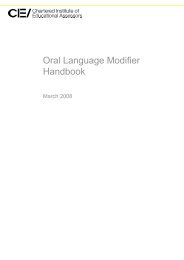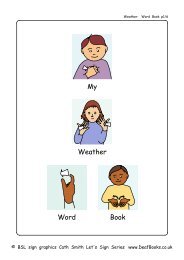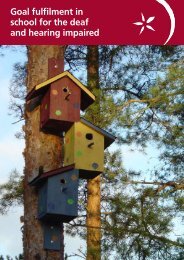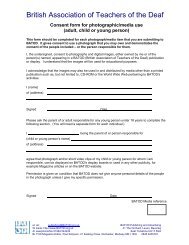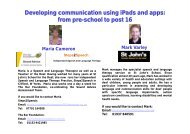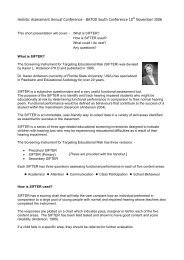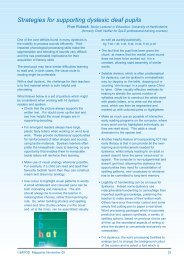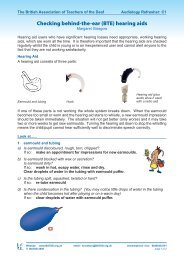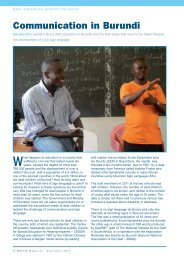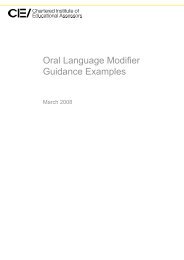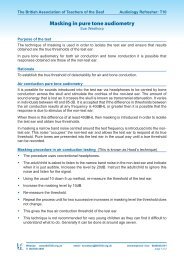Article and examples of instruction sheets - batod
Article and examples of instruction sheets - batod
Article and examples of instruction sheets - batod
Create successful ePaper yourself
Turn your PDF publications into a flip-book with our unique Google optimized e-Paper software.
-<br />
South <strong>of</strong> Engl<strong>and</strong> Cochlear Implant Centre<br />
Barb Hay, SOECIC (March 2005) <strong>and</strong> Pauline Cobbold (December 2011)<br />
From an article on the BATOD website<br />
www.BATOD.org.uk<br />
Publications>>BATOD On-line Magazine >>Focus on Cochlear Implants
Creating a listening box<br />
What are Listening Boxes<br />
Why were they developed<br />
When are Listening Boxes used<br />
How are they used<br />
Conclusion<br />
Parent Comments on Listening Boxes<br />
Examples <strong>of</strong> <strong>instruction</strong> <strong>sheets</strong><br />
• The wheels on the bus<br />
• Scruffy Teddy dinner time<br />
• Five little ducks<br />
• Farm animals
South <strong>of</strong> Engl<strong>and</strong> Cochlear Implant Centre<br />
Barb Hay, SOECIC (March 2005) <strong>and</strong> Pauline Cobbold (December 2011)<br />
We developed the Listening Boxes to help parents when both a SLT <strong>and</strong> a ToD were<br />
working with a family. This meant that the ToDs would have quite big gaps between visits.<br />
The Listening Boxes fell into disuse because we failed to get them back because <strong>of</strong> the long<br />
gaps or items were lost by the families.<br />
We needed a lot more <strong>of</strong> the very early ones <strong>and</strong> for various reasons this was not possible.<br />
Some families developed the idea that they could not use their own toys but with others it<br />
helped them focus <strong>and</strong> was very successful.<br />
A small number with local nurseries showing them how they could develop resources based<br />
on the ideas guidance sheet which was left with them.<br />
Barb Hay, a ToD from New Zeal<strong>and</strong> spent some time further developing the boxes <strong>and</strong> her<br />
ideas were very much based on AVT strategies. We still have all the electronic versions <strong>of</strong><br />
the help <strong>sheets</strong> but sadly the actual toys have been lost or reused elsewhere.<br />
Some <strong>examples</strong> <strong>of</strong> the <strong>sheets</strong> are available <strong>and</strong> these can easily be adapted to other books<br />
<strong>and</strong> toys. Please, if the <strong>sheets</strong> are used as a basis for development, note a credit to SOEIC.<br />
Creating a listening box Barb Hay, SOECIC (March 2005)<br />
Listening Boxes evolved from Listening Bags, an idea used by various CI Centres <strong>and</strong><br />
Education teams to provide parents with structured activities to assist the development <strong>of</strong><br />
listening skills. The boxes are used as part <strong>of</strong> the rehabilitation programme for children who<br />
have had cochlear implants.<br />
What are Listening Boxes<br />
Listening Boxes are sturdy, stackable, portable, easily recognisable <strong>and</strong> contain specific<br />
activities, targeting a range <strong>of</strong> particular listening skills. The contents always include toys to<br />
reinforce a particular skill, usually the words to a song or rhyme for parents to sing with their<br />
children (remembering the importance <strong>of</strong> developing pitch, rhythm <strong>and</strong> intonation) <strong>and</strong> a<br />
book for shared reading. The contents are listed on laminated <strong>sheets</strong> which provide advice<br />
<strong>and</strong> step by step <strong>instruction</strong>s on how to use the items effectively.<br />
Why were they developed<br />
Listening Boxes were developed to build up children's listening skills <strong>and</strong> to give parents<br />
specific ideas on how to support their child's listening development. Each box provides ideas<br />
on how children can experience sound in a meaningful <strong>and</strong> fun way. Before parents leave<br />
the Centre the ideas contained in the box are explained, along with suggestions <strong>of</strong> how the<br />
box could be used at home. An underlying aim is to encourage parents <strong>and</strong> families to spend<br />
regular 'quality' time at home reinforcing the skills between visits from centre staff.
When are Listening Boxes used<br />
Listening Boxes are particularly useful at early stages <strong>of</strong> development, to demonstrate to<br />
parents how to work with their child on listening skills. Each Box has a specific reference to a<br />
listening stage:<br />
• auditory detection (knowing there is sound present);<br />
• auditory discrimination (knowing that there are different types <strong>of</strong> sound);<br />
• identification (knowing what the sound represents eg doorbell);<br />
• comprehension (knowing that words/sounds have meaning <strong>and</strong> acting on that).<br />
The activities are used to reinforce listening skills on a 1:1 basis whilst integrating<br />
meaningful concepts in a fun way.<br />
How are they used<br />
A simple step-by-step laminated <strong>instruction</strong> sheet is included on how to use the Listening<br />
Boxes. The specific purpose <strong>and</strong> goals for the box are on the front. From the front <strong>of</strong> the box,<br />
parents <strong>and</strong> pr<strong>of</strong>essionals can quickly <strong>and</strong> easily see the specific listening intent <strong>of</strong> each box.<br />
A box developed to encourage auditory detection may simply have 'responding to sound'<br />
<strong>and</strong> 'turn taking' as its specific goals. The box may only contain a drum <strong>and</strong> a ball with<br />
<strong>instruction</strong>s on how these may be used to develop the skill <strong>of</strong> auditory detection. The advice<br />
may include;<br />
a. banging the drum while encouraging the child to 'listen';<br />
b. s<strong>of</strong>t <strong>and</strong> loud banging;<br />
c. marching to the beat <strong>of</strong> the drum;<br />
d. playing the 'Wake Up' game - taking turns to be asleep <strong>and</strong> waking up when the<br />
drum is banged;<br />
e. throwing the ball when they hear the beat <strong>of</strong> the drum;<br />
f. playing a simple hide <strong>and</strong> seek game with the drum.<br />
A more complex Listening Box may involve developing the skills <strong>of</strong> auditory identification or<br />
comprehension, including activities in, for example, auditory selection, turn-taking, auditory<br />
memory, singing, role play <strong>and</strong> language building.<br />
A 'loan card' system ensures a record <strong>of</strong> who has borrowed the box <strong>and</strong> the date <strong>of</strong> return.<br />
Conclusion<br />
It is fun collecting items <strong>and</strong> making Listening Boxes <strong>and</strong> the production reaps rewards <strong>and</strong><br />
good feedback from both the children <strong>and</strong> their parents. The boxes are widely used <strong>and</strong> they<br />
are an invaluable tool in assisting parents in the development <strong>of</strong> their children's listening.
Parent Comments on Listening Boxes:<br />
• 'Very inspirational.'<br />
• 'Interesting with lots <strong>of</strong> variety.'<br />
• 'Inspires parents to have confidence to work with their child'.<br />
• 'I like the suggested activity <strong>and</strong> how it's broken down.'<br />
• 'Captures my child's attention.'<br />
March 2005<br />
Pauline Cobbold<br />
South <strong>of</strong> Engl<strong>and</strong> Cochlear Implant Centre<br />
Building 19<br />
Highfield Campus<br />
Southampton<br />
SO17 1BJ<br />
Tel: 02380 593522<br />
Email: pc@isvr.soton.ac.uk
CONTENTS:<br />
Book – The Wheels on the Bus<br />
Bus- With driver <strong>and</strong> 8 animals/ people.<br />
The Story <strong>and</strong> Game:<br />
• Read the book with your child. Use a sing song voice.<br />
• Re read the story using actions as you sing along with the book.<br />
• Introduce the bus with all the various animals <strong>and</strong> people. Make noises for<br />
the animals after you see them <strong>and</strong> name them, along with the people.<br />
• Use the bus to sing the song with the animals <strong>and</strong> people as props. Put as<br />
much expression into this as possible, while encouraging your child to join in<br />
both vocally <strong>and</strong> with the actions.<br />
• Hide the animals <strong>and</strong> make the noise they might make before pulling them<br />
out. (This is not a test – just leave it a second or two before showing your<br />
child the animal).<br />
• Make an animal sound <strong>and</strong> then show the wrong animal – make a big fuss<br />
about being wrong.<br />
• Follow your child’s ideas <strong>and</strong> choices <strong>and</strong> encourage them to do the story for<br />
you. When rereading the book, try to get your child to anticipate ‘what comes<br />
next’ Make a game <strong>of</strong> this. Give choices. Do you think it’s the wipers going<br />
swish, swish, swish or the lights going flash, flash, flash<br />
• Play counting games to count how many people/ animals are on the bus.<br />
• Line up the animals <strong>and</strong> say the sound that the animal might make. See if<br />
your child can select the appropriate animal. Move on to the name <strong>of</strong> the<br />
animal once this is accomplished.<br />
• When putting the animals away ask for one item at first e.g. ‘ Give me the<br />
dog’. Move on to 2 items e.g. ‘Give me the dog <strong>and</strong> the giraffe.’ Increase to 3.<br />
ENJOY!<br />
Please do not leave your child unsupervised with the listening box or its<br />
contents. Thank you.
Listening Bag<br />
CONTENTS:<br />
Book – Scruffy Teddy Dinner Time<br />
Tea set x 14 pieces<br />
2 x bears<br />
The Story <strong>and</strong> Games:<br />
• Read the book with your child. Make the noises for each part <strong>of</strong> the story – “Yum”, “Splish<br />
Splosh”.<br />
• Look through the book, naming all the items – saucepan, jelly, table etc.<br />
• Use the tea set <strong>and</strong> make your own noises – noisily slipping tea, putting cups on saucers.<br />
• Use lots <strong>of</strong> expression in your voice <strong>and</strong> on your face!<br />
• Name the different parts <strong>of</strong> the tea set. After a few days <strong>of</strong> using the tea set, spread the<br />
items on the table before you have ‘tea’. Say the name <strong>of</strong> the item <strong>and</strong> pause before picking<br />
it up (this is not a test – just leave it a few seconds before taking an item).<br />
• Have a tea party with your child <strong>and</strong> the teddy bears. Take turns being the host. Ask if your<br />
guests would like ‘tea’ or ‘sugar’ or ‘milk’.<br />
• Make your own noises while cooking or getting ready for a meal. Just like the book.<br />
• Sing the song several times encouraging your child to join in. Use the teddy as a prop for<br />
teddy bear song. Use the clean up song when tidying away after the tea party.<br />
Songs:<br />
If you go down to the woods today<br />
You’re in for a big surprise<br />
If you go down to the woods today<br />
You better go in disguise<br />
For every bear that ever there was<br />
Is gathered there together because<br />
Today’s the day the teddy bears have their picnic!<br />
Clean up, clean up<br />
Everybody do your share<br />
Clean up , clean up<br />
Everybody everywhere.<br />
Enjoy!<br />
Please do not leave your child unsupervised with the listening box or its contents. Thank you.
Listening Bag<br />
This activity is for everyone in the family <strong>and</strong> for friends to play with your<br />
child<br />
Contents:<br />
Book – Five Little Ducks<br />
Five Little Ducks + Mother Duck.<br />
Bag<br />
The game:<br />
• Take the book out <strong>of</strong> the box, read the book to your child. Use lots <strong>of</strong><br />
expression as you read.<br />
• Put your h<strong>and</strong> in the bag <strong>and</strong> say ‘quack quack’.<br />
• Get Mummy duck out.<br />
• Encourage your child to take turns <strong>and</strong> put his/ her h<strong>and</strong> in, say ‘quack quack’<br />
then get a duck out. Give him lots <strong>of</strong> praise when he says ‘quack quack’<br />
before he takes the duck out.<br />
• Show him/her Mummy duck <strong>and</strong> the baby ducks, pointing to each in turn,<br />
counting the ducks as you do this.<br />
• Read the book with a singing action, using the Sing the song carrying out the<br />
actions with the ducks.<br />
Song:<br />
Five little ducks went swimming one day,<br />
Over the hills <strong>and</strong> far away,<br />
Mummy duck called “quack quack quack! ”<br />
But only four little ducks came back.<br />
Four little ducks went swimming one day,<br />
Over the hills <strong>and</strong> far away,<br />
Mummy duck called “quack quack quack! ”<br />
But only three little ducks came back.<br />
Three little ducks went swimming one day,<br />
Over the hills <strong>and</strong> far away,<br />
Mummy duck called “quack quack quack! ”<br />
But only two little ducks came back.<br />
Two little ducks went swimming one day,<br />
Over the hills <strong>and</strong> far away,<br />
Mummy duck called “quack quack quack! ”<br />
But only one little duck came back.<br />
One little ducks went swimming one day,<br />
Over the hills <strong>and</strong> far away,<br />
Mummy duck called “quack quack quack! ”<br />
But no little ducks came back.
CONTENTS:<br />
Book – Farm Animals<br />
Animals- horse, sheep, pig, duck, hen, cow<br />
Bag<br />
The Story <strong>and</strong> Game:<br />
• Read the story <strong>and</strong> find the animals.<br />
• Re read the story finding plastic animals as they appear.<br />
• Make noises for the animals after you see them <strong>and</strong> name them.<br />
• Match the toy animals to the picture ones.<br />
• Hide the animals in the bag <strong>and</strong> make their noise before pulling them out.<br />
(This is not a test – just leave it a second or two before showing your child the<br />
animal).<br />
• Make an animal sound <strong>and</strong> then show the wrong animal – make a big fuss<br />
about being wrong.<br />
• Follow your child’s ideas <strong>and</strong> choices <strong>and</strong> encourage them to do the story for<br />
you.<br />
• Play counting games to count how many <strong>of</strong> each sort <strong>of</strong> animal is in the book.<br />
• Line up the animals <strong>and</strong> say the sound that the animal makes. See if your<br />
child can select the appropriate animal. Move on to the name <strong>of</strong> the animal<br />
once this is accomplished.<br />
• When putting the animals away ask for one item at first e.g. ‘ Give me the<br />
horse’. Move on to 2 items e.g. ‘Give me the sheep <strong>and</strong> the duck.’ Increase to<br />
3 <strong>and</strong> 4.<br />
• Use the farm mat to put the animals in different places. Talk about these,<br />
moving the animals about talking about the activities the animals might do.<br />
e.g. ‘Here’s the duck, he’s going to swim in the water. SPLASH, SPLASH!’<br />
‘Here’s the cow. He’s going to eat the hay. Yum! Yum! Use lots <strong>of</strong> expression!<br />
• Sing Old MacDonald with your child. Using the animals from the story let your<br />
child choose which animals are on the farm. Sing the song <strong>and</strong> you choose<br />
the animals. See if your child can find the one to match the noise you make.<br />
ENJOY!<br />
Please do not leave your child unsupervised with the listening box or its<br />
contents. Thank you.
CONTENTS:<br />
5 buns/ cakes<br />
9 fruit <strong>and</strong> vegetables<br />
Book- At the shops<br />
Bag with coins<br />
The Book <strong>and</strong> Games:<br />
• Put your h<strong>and</strong> in the box <strong>and</strong> say ‘mmmmm’ (a rub on your tummy will indicate to your child<br />
that it is something to eat).<br />
• Get out a bun/ cake <strong>and</strong> put it on the table.<br />
• Encourage your child to take turns <strong>and</strong> put his/ her h<strong>and</strong> in. Say ‘mmmm’ then get a bun out.<br />
Give him lots <strong>of</strong> praise when he says ‘mmmm’ before he takes the bun out.<br />
• Count them, pointing to each in turn… 1,2,3,4,5 currant buns<br />
• Give your child one penny <strong>and</strong> say/sing the song. When his name is said, encourage him to<br />
give you the penny in return for a bun.<br />
• Look at the pictures in the book together <strong>and</strong> talk about the things to eat. Use ‘mmmmmm’<br />
that’s nice, or, ‘ I like that, it’s yummy’ or ‘I don’t like this, do you’ or a similar phrase.<br />
• Take the fruit <strong>and</strong> vegetables out <strong>of</strong> the box one at a time, name them <strong>and</strong> match them to the<br />
pictures in the book. Match other items in the book to items you have in the home.<br />
• Line up three <strong>of</strong> the fruit or vegetables. Name them several times <strong>and</strong> see if your child can<br />
select the appropriate fruit or vegetable. Increase the number <strong>of</strong> fruit/ vegetables available for<br />
selection (till you reach 6 items for display <strong>and</strong> your child can successfully select one <strong>of</strong><br />
these).<br />
• When putting the fruit/ vegetables away ask for one item at first. e.g. ‘Give me the banana.’<br />
Move to two items. e.g. ‘Give me the banana <strong>and</strong> the orange’. Increase to 3, as your child is<br />
able to easily cope with this.<br />
• Use all the items <strong>and</strong> money to play a shopping game, taking turns at asking for various<br />
items.<br />
Song:<br />
5 currant buns in a baker’s shop<br />
Round <strong>and</strong> fat with sugar on the top<br />
Along came ……….with a penny one day<br />
Bought a currant bun <strong>and</strong> took it away<br />
4 currant buns in a bakers shop…., then 3,2,1<br />
ENJOY!<br />
Please do not leave your child unsupervised with the Listening bag or its contents. Thank<br />
you.



